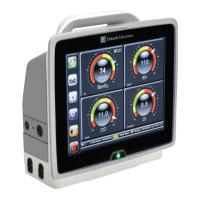49
HemoSphere Advanced Monitor 3 Installation and Setup
3.3.5 Connecting and Disconnecting a Hemodynamic Monitoring Cable
Both monitoring cable ports are equipped with a magnetic latch mechanism. Inspect the cable for damage
before connecting. A monitoring cable will snap into place when it is properly seated in the port. To
disconnect a cable, hold at the plug to pull it away from the monitor.
3.3.6 Connecting Cables from External Devices
The HemoSphere advanced monitor utilizes slaved-in monitored data to calculate certain hemodynamic
parameters. This includes data from the pressure input data ports and ECG monitor input port. All slaved-
in cable connections are located on the rear panel of the monitor (figure 3-2). See Required Accessories for
Platform Modules and Cables on page 42 for a list of calculated parameters available with certain cable
connections. For more information on configuring the analog pressure ports, see Analog Pressure Signal Input
on page 95.
IMPORTANT NOTE The HemoSphere advanced monitor is compatible with pressure
and ECG analog slave inputs from any external patient monitor that
has analog slave output ports which meet the signal input specifica-
tions identified in appendix A, table A-4 of this operator’s manual.
These provide a convenient means to utilize information from a
patient monitor to calculate additional hemodynamic parameters
for display. This is an optional feature that does not impact the
HemoSphere advanced monitor’s primary function of monitoring
cardiac output (with the HemoSphere Swan-Ganz module) and
venous oxygen saturation (with the HemoSphere oximetry cable).
WARNING Only use HemoSphere advanced monitor accessories, cables and or components that
have been supplied and labeled by Edwards. Using other unlabeled accessories, cables
and or components may affect patient safety and measurement accuracy.
Status = Released Printed Date: 2018-01-16 Released Date: 2017-09-14

